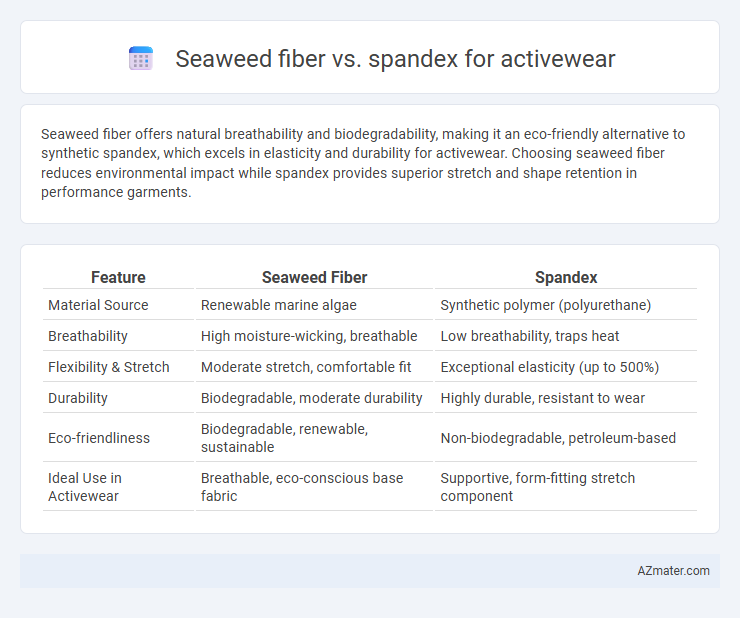Seaweed fiber offers natural breathability and biodegradability, making it an eco-friendly alternative to synthetic spandex, which excels in elasticity and durability for activewear. Choosing seaweed fiber reduces environmental impact while spandex provides superior stretch and shape retention in performance garments.
Table of Comparison
| Feature | Seaweed Fiber | Spandex |
|---|---|---|
| Material Source | Renewable marine algae | Synthetic polymer (polyurethane) |
| Breathability | High moisture-wicking, breathable | Low breathability, traps heat |
| Flexibility & Stretch | Moderate stretch, comfortable fit | Exceptional elasticity (up to 500%) |
| Durability | Biodegradable, moderate durability | Highly durable, resistant to wear |
| Eco-friendliness | Biodegradable, renewable, sustainable | Non-biodegradable, petroleum-based |
| Ideal Use in Activewear | Breathable, eco-conscious base fabric | Supportive, form-fitting stretch component |
Introduction to Seaweed Fiber and Spandex in Activewear
Seaweed fiber is an innovative, sustainable textile derived from marine algae, offering natural antimicrobial properties, moisture-wicking ability, and biodegradability ideal for eco-conscious activewear. Spandex, a synthetic fiber known for exceptional elasticity and shape retention, provides superior stretch and durability, making it a staple in performance-driven activewear. Both materials meet specific demands, with seaweed fiber emphasizing sustainability and skin benefits, while spandex ensures flexibility and long-lasting wear.
Sustainability: Seaweed Fiber vs Spandex
Seaweed fiber offers a sustainable alternative to spandex in activewear, deriving from renewable marine plants that require minimal resources and reduce ocean pollution. Spandex production relies on petrochemicals, contributing to carbon emissions and microplastic pollution in water systems. Integrating seaweed fiber in activewear enhances biodegradability and lowers environmental impact compared to synthetic spandex blends.
Performance and Comfort Comparison
Seaweed fiber offers superior moisture-wicking and natural antibacterial properties, enhancing comfort during intense workouts by reducing odor and skin irritation. Spandex excels in elasticity and shape retention, providing exceptional stretch and recovery for dynamic movements in activewear. Combining seaweed fiber's breathable, eco-friendly benefits with spandex's flexibility results in performance apparel that balances comfort and durability.
Moisture-Wicking and Breathability
Seaweed fiber in activewear offers superior moisture-wicking properties by naturally absorbing and releasing sweat, keeping the skin dry and comfortable during intense workouts. Its breathable structure allows enhanced air circulation, reducing heat buildup compared to spandex, which tends to trap moisture and heat due to its synthetic composition. Combining seaweed fiber with spandex can optimize both breathability and stretch, creating activewear that supports moisture management and flexibility.
Stretch and Flexibility: Key Differences
Seaweed fiber offers moderate stretch and excellent moisture-wicking properties, enhancing comfort and breathability in activewear, while spandex provides superior elasticity with up to 500% stretch, ensuring maximum flexibility and shape retention. Seaweed fiber blends typically provide a softer, more natural feel but less recovery compared to the high-performance, resilient stretch of spandex. Choosing between them depends on the desired balance of sustainability, comfort, and stretch responsiveness in activewear fabrics.
Durability and Longevity
Seaweed fiber offers natural breathability and moisture-wicking properties but generally falls short in durability compared to spandex, which provides superior elasticity and resilience essential for activewear. Spandex fibers can withstand repeated stretching and washing cycles, maintaining shape and fit over time, making them a preferred choice for longevity. While seaweed fiber enhances comfort, spandex ensures prolonged garment performance under rigorous physical activity.
Skin Sensitivity and Hypoallergenic Properties
Seaweed fiber offers excellent skin sensitivity benefits due to its natural softness and moisture-wicking capabilities, reducing irritation and maintaining comfort during physical activity. It is inherently hypoallergenic, making it suitable for individuals with sensitive skin or allergies, whereas spandex, although stretchy and durable, can sometimes cause skin irritation or allergic reactions in sensitive users. Choosing seaweed fiber activewear supports breathable, gentle contact with the skin, promoting better overall dermatological health compared to synthetic spandex fabrics.
Environmental Impact and Biodegradability
Seaweed fiber offers a sustainable alternative to spandex in activewear due to its renewable source and low environmental footprint, as it requires minimal water and no harmful chemicals during production. Unlike synthetic spandex, which is derived from petrochemicals and contributes to microplastic pollution, seaweed fiber is fully biodegradable, breaking down naturally without releasing toxins. Choosing seaweed fiber supports eco-friendly fashion by reducing plastic waste and promoting circularity in textile materials.
Market Trends and Consumer Preferences
Seaweed fiber is gaining traction in the activewear market due to its eco-friendly properties, biodegradability, and natural antibacterial benefits, appealing to environmentally conscious consumers seeking sustainable alternatives. Spandex remains dominant for its superior stretch, durability, and moisture-wicking capabilities, making it a staple in performance-oriented activewear brands. Market trends indicate a growing hybrid use of seaweed fiber blended with spandex to optimize comfort, sustainability, and functionality, reflecting shifting consumer preferences toward responsible fashion without compromising performance.
Future Prospects of Seaweed Fiber in Activewear
Seaweed fiber offers promising future prospects in activewear due to its sustainability, biodegradability, and natural antibacterial properties, which enhance comfort and odor resistance during workouts. Unlike spandex, which relies heavily on non-renewable petrochemicals, seaweed fiber presents an eco-friendly alternative that aligns with the growing demand for green and circular fashion solutions. Ongoing innovations in seaweed fiber extraction and blending technologies are expected to improve fabric stretch and durability, positioning it as a competitive material in performance-focused activewear markets.

Infographic: Seaweed fiber vs Spandex for Activewear
 azmater.com
azmater.com